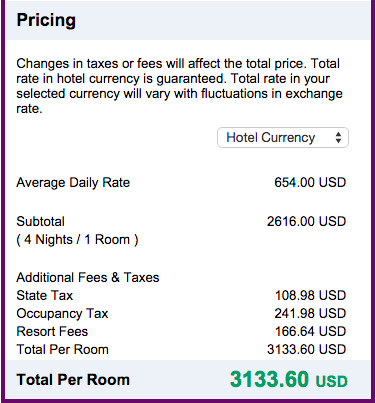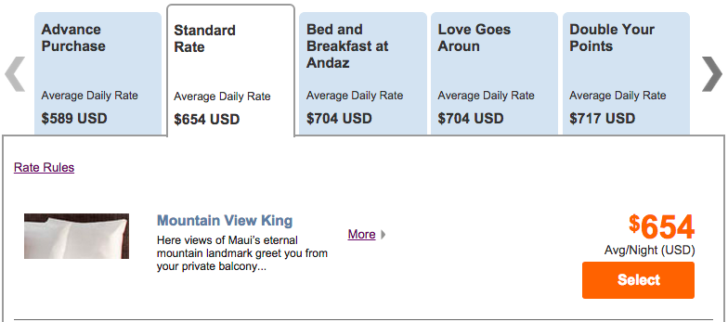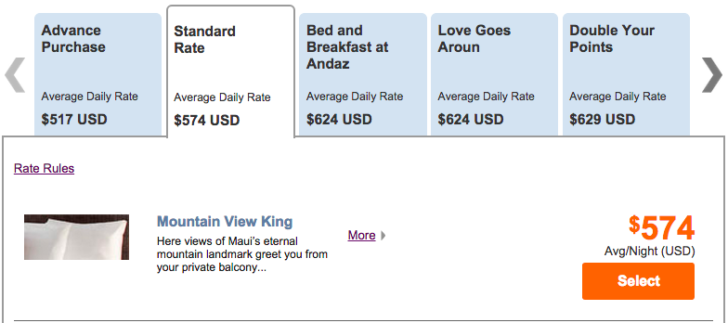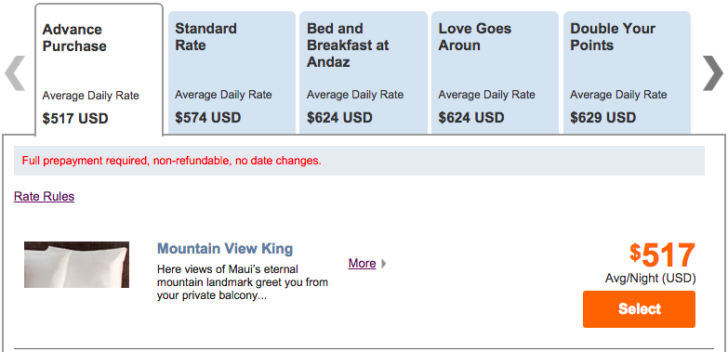While many guests book hotel stays for more than one night, the rates that hotels advertise can change on a daily basis during that stay. So which price do you actually end up paying? Some hotels really do consider the lowest available rate on every day and calculate an average. Others charge the highest rate on any one day for the entire stay, which can significantly raise the cost of the final bill.
Even hotels that advertise an “average daily rate” still do this. The IT system just isn’t capable of calculating the average and displaying it correctly. And for those hotels that have their act together, you can still run into problems with different rate categories (not different prices for the same rate) available on some days but not others.
Let’s look at the Andaz Maui in Wailea for an example of this. It’s a great hotel, but award availability has been tough to come by lately. If you can afford to pay for a standard room, I think it could still be a good deal when upgraded to a suite. For an upcoming four-night stay in February, here is the advertised rate for the entire stay:
And you can see this “average” rate confirmed on the booking confirmation page.
But now lets look at the rate one day at a time. The first two nights (February 13 and 14) don’t change from what we saw for the entire four-night stay. Even on the third night, the standard rate that we’re looking at stays the same, although a new non-refundable rate appears.
On the fourth night, prices drop for both the standard rate and the non-refundable rate.
So if we were to book the standard rate as two separate reservations, we could save some money. Here’s how it works out:
Reservation 1 (February 13-16): $654/night
Reservation 2 (February 16-17): $574/nightTotal savings (excl. taxes) = $80
That’s $80 for five minutes of extra work. Use it to buy a couple of lunches by the pool. I don’t know why this hotel calls it an “average” rate when it clearly is not the average price of the same rate category over four days. But in the travel world I’ve learned that asking such questions isn’t always productive. The point is, if you pay attention and think on your own you can save some money.
Let’s imagine that you find a hotel that does a better job of calculating an average daily rate. Does this trick still matter? Yes. The reason is that even if the hotel can adjust the rate as it changes a daily basis, there can still be different rates available on each day. In the example above, a cheaper non-refundable rate was only available on Monday and Tuesday, whereas a more expensive “standard rate” was available every day. You may be willing to book a non-refundable, advance purchase rate to save money but cannot do this for your entire stay.
Only if you checked rates on a daily basis would you know that you could split the reservation and save money: one two-night stay at the standard rate and one two-night stay at the advance purchase rate. Because the advance purchase rate changes during your stay, I would recommend you actually make three different reservations.
Reservation 1 (February 13-15): $654/night
Reservation 2 (February 15-16): $589/night
Reservation 3 (February 16-17): $517/nightTotal savings (excl. taxes) = $202
That’s even better! Two hundred dollars will buy you dinner for two at Ka’Ana Kitchen or, if you control your appetite, you can even go to Morimoto Maui. Remember I’m only looking at a four-night stay here. The savings add up on longer stays or when the price differential is greater (e.g., a major conference one night, and an empty hotel the day after).
Keep this tip in mind the next time you face an unexpectedly high rate. It may be that you’ve been snagged by the trap of paying the highest rate on every day of your stay. Book separate reservations to save money, and in most cases the hotel can still keep you in the same room for the duration of your stay or even apply an upgrade.











